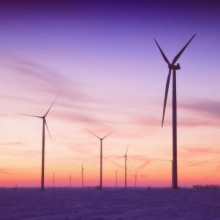
AI, Analytics Help to Propel Wind Power

Clean energy sources such as wind turbines are among the edge devices being incorporated into the Internet of Things. Once connected, the growing number of wind turbines sprouting up across Asia, Europe and the American Midwest and along its coasts are making greater use of AI and analytics as way to improve performance and accelerate return on investment.
Asset management vendors incorporating AI and analytics technologies with cloud computing are emerging to deliver tools like performance analytics. Among them is the Canadian vendor Universal mCloud Corp. which over the last several months has announced several deals with wind farm operators aimed at leveraging data from turbine sensors while boosting performance and reliability.
This week, the Vancouver-based asset manager (TSX-V: MCLD) (OTCQB: MCLDF) announced an agreement with Longyuan Wind Power Co. to provide performance analytics tools. mCloud’s asset management platform will initially be used to assess and tweak the performance of wind turbine pitch systems and batteries for 35 GE turbines at the Chinese energy firm’s wind farm.
Longyuan is China’s largest wind farm developer and operator. The Chinese energy market is estimated to account for about one-third of global installed wind capacity.
The performance analytics deal with Longyuan follows a similar one inked by mCloud in March with BritWind, which specializes in wind energy production, operations and maintenance, including retrofits to existing wind turbines across the U.K.
The agreement calls for the partners to offer subscription-based turbine upgrades based on mCloud’s AI and analytics tools used to boost turbine performance. The partners are also offering a five-year warranty on their wind turbine upgrade package.
The Canadian firm’s flagship AssetCare platform applies historical data from wind turbines to its analytics and AI tools to determine, for example, the optimum pitch angles for wind turbines. Along with blade position relative to prevailing winds, other parameters include torque, motor temperature and current. Performance variables include wind speed and direction, power output and turbine mode.
Those metrics are used to detect excessive rotational force or stresses on turbine controls. The energy analytics platform can then predict annual energy production and turbine longevity. The goal is to reduce operation and maintenance costs as a way to boost wind energy producers’ profitability per megawatt-hour.
Recent items:
How Machine Learning Can Help Us Stop Climate Change
Predictive Analytics Prevailing on the Wind Farm



























